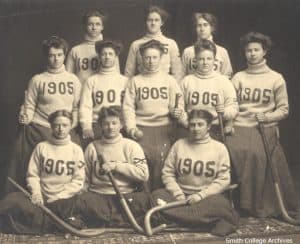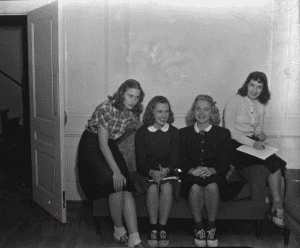William Smith and Seven Sisters Style from the 1940s-1970s
By Maya Alvarez, William Smith College Summer Intern
If you have any interest in classic American women’s fashion, you’ve likely heard of the Seven Sisters. Based in the northeast, Barnard, Bryn Mawr, Mount Holyoke, Radcliffe, Smith, Wellesley, and Vassar are historically women’s private liberal arts colleges who founded a signature fashion style. The colleges were all founded in the late nineteenth century, at a time when women weren’t allowed to enroll in Ivy league universities. Naturally, these colleges established a style rooted in exclusivity, reflecting their rigorous education rivaling their male counterparts.
There’s no doubt that the Seven Sisters are iconic institutions within the American collegiate system, but they’re not the only historically women’s colleges in the Northeast. Geneva’s William Smith College was founded in 1908 and has just as rich history as the Seven Sisters. As a college founded on radical thought, there is no surprise that William Smith students were inspired by the radical fashion choices of the Seven Sisters.
The Seven Sisters Style
Did you know that the prep-school style you think of today originates from the Seven Sisters? Think Gossip Girl, Gilmore Girls, Clueless – we have the northeast women’s colleges to thank for their iconic looks. But what exactly is the coveted Seven Sisters style?
In the late 19th century, to create a sense of community in their newly founded schools, Barnardites, Smithies, Vassarites, Mawrters, Sibs, Cliffies, and MoHo girls established a style that exploded in popularity over the years. Inspired by the Ivy league tradition of incorporating sportswear into everyday looks, women of the colleges donned blazers, letter sweaters, and letterman jackets that translated well on and off the field.[i] To accoutre oneself in these garments showed a student’s dedication to their reputable source of higher education and athleticism, garnering school pride in the process.[ii]
In the 1910s and 1920s, wearing more obvious homages to menswear was all the rage, challenging the traditional gender roles of the time. Suits, cravats, ties, caps, even their grandpa’s raccoon fur coat were popularized on these campuses, affirming the students place as an “Ivy League woman.”[iii] In the 1930s, exceptionally worn-in saddle shoes, kilts, striped scarves, button down blouses, and neckties in college colors came onto the scene.[iv] With Bermuda being a popular vacation spot, it’s only natural that a certain island-influence would emerge. Bermuda shorts became a defining clothing item of female collegiate style, varying in colors and patterns as the garment evolved.
The clothes these women wore weren’t just comfortable but signified a shift in power given to these well-educated students. The emergence of many of these clothing items date back to the women’s prep school uniforms. By taking an element of life that was once dictated by an authority figure and choosing which elements to wear into adulthood was an awfully feminist ideal for the time. These radical fashion choices “[began] a style revolution that would transform the wardrobes of women everywhere.”[v]
The classic Seven Sisters style that we know today is a reaction to the post-war and post-depression era. After years of fighting and uncertainty, things started to slowly return to normal, but with hints of idealization and romanticism. The late 1940s was a period where we “saw the gradual revival of the clothing industries and a renaissance of elegance.”[vi] After a long period of shortage of materials, the fashion industry boomed, with boutiques popping up seemingly everywhere, making the newest styles accessible to the wider public.[vii] Now was the perfect time for fashion industries to capitalize off of new clientele, but there was a shift in their audience. In a pre-war world, older women ran the fashion scene, but by the 1940s, as museum curator and writer François Boucher states, “It is indeed the younger woman who now dictates even the main lines of fashion. The accent is on youth…”[viii]
During World War II factory women popularized denim, something that would soon become staples at the Seven Sisters.[ix] The attendees of the schools realized during the 1940s how convenient the garment was. Jeans were comfortable, offered flexibility to the wearer, and required minimal laundering.[x] Thus, again arose allegations of “manliness” towards the girls, as they sported their dusty rolled-up jeans, button down shirts (with shirttails flying free), oversized polo coats thrown messily on top, ending gracefully with the addition of loafers to tie the look together.[xi]
There are very few things more important to a Seven Sisters woman than keeping family tradition alive, but by doing this they may exploit their privileged upbringing. In a nutshell the institutions these well-dressed women attended were, “elite bastions of exclusivity and intelligence”[xii] for the white woman who had strong roots in her country.
The privilege of these students oozed from the heirlooms that adorned them. The women acquired timeless pins and brooches from grandma, perfect to jazz up the cashmere cardigan (sleeves pushed above the elbows of course) that she “borrowed” from mom. Wearing grandpa’s racoon coat was the perfect way to stay en vogue during a 1920s trend revival in the 1950s. Charm bracelets were also used to express how well traveled a girl was, another symbol of status, and this fad hit it so big, major stores including Tiffany and Co. sold these charms.
Willy-Smither Style and the Lingering Presence of Hobart Men
Despite the laid-back approach of their dress on campus, no matter how expensive their outfit may be, the women of the Seven Sisters still knew when to follow the general fashion rules of the time. Over the weekend, girls would dress up in their nicest skirts, McMullen blouses, Shetland sweaters, and more lavish items, as it became apparent that, “Seven Sisters only dressed up for men.”[xiii] This simple shift in who is viewing these women is what sets William Smith College’s fashion choices apart from the other institutions discussed. Since the women were sharing a campus with men, they dressed like it was the weekend almost every day.
Earlier, I had touched on the staple items of the Seven Sisters style: the button down, cardigan, blazers, saddle shoes, loafers, and jeans. Almost all of these are explicitly present in William Smith dress from the 1930s-1960s, but one item didn’t make a public appearance until much later. Jeans were almost completely absent from the public eye at William Smith until the 1970s. After combing through both the archives at Historic Geneva and HWS, the presence of jeans on William Smith students remained relatively hidden, only available in places that the female viewer could see.
The Pine Yearbook, started in 1912 by William Smith students, holds a glimpse into the raw emotions of the students, specifically a version of them that didn’t care about the lingering men at the bottom of the hill. Rolled up jeans can be spotted in The Pine as early as 1944, and it looks as though this garment was frequently worn indoors, and in the harsh upstate snow. The significance of the concealment of jeans further exploits the William Smith girl’s desire to not be viewed as “manly” by the men surrounding them, akin to what the rest of the world was doing to the Seven Sisters women who bravely sported a pair. The record of these laid-back William Smith students through the female gaze is altered when the school combined their yearbook with Hobart College in 1962, and from then until at least the mid-1970s, William Smith students were presented to the world as the “prim-and-proper” girls that their middle-to-upper class parents wanted them to be.
Willy-smithers followed the Seven Sisters “feminine” style of dress to a T. There are countless examples of these women sporting pin-curled bobs with button-front cardigans, paired with a peter pan collar peeking out, knee length skirts, slouchy socks, and saddle shoes during the 1940s. On fancier occasions they wore either matching sets of blouses and skirts, or a simple yet elegant dress with pearls and heels. On colder days, the women didn’t shy away from a wool statement blazer, or luxury knit Shetland sweater and plaid skirt.
During this era, the women were rarely seen without their lips painted bright red, even when they were simply captured in their rooms studying. Not only was this makeup choice fashionable, but political as well, as red lipstick has origins in women’s suffrage where makeup revolutionary Elizabeth Arden influenced suffragettes to wear lipsticks as a, “badge of courage.”[xiv] During WWII, red lipstick became an anti-fascist statement for the citizens of the allied powers, as Hitler notably hated the look, and shades of red were even matched to trimmings of the fighting woman’s uniform.[xv] Thus, the Genevan students joined millions of other women in supporting their country through cosmetic choices.
Again, during the 1950s, pants were seen almost exclusively in The Pine as to not give the wrong idea to possible suitors. Bowties and vests soon begin to make an appearance at William Smith in this decade, but a shift back towards tradition is evident in the early 1960s. It appears, in photos, that the willy-smithers of the swinging sixties were again, wearing the classic Brooks Brothers button downs, camel hair coats, and crewneck sweaters. Skirts were still the preferred clothing item of choice, though they did gradually grow shorter during this decade. In almost every photo of the students during this time, the woman of choice is sporting a pair of brown loafers, likely from the classic G. H. Bass brand, who made shoes for stars like Audrey Hepburn’s. Looking to more stars for inspiration, camel hair coats were replaced by the utilitarian trench. Superstars of the time like Marlene Dietrich, Sophia Loren, and Twiggy, all famously sported the garment. With their influence, it seems as though the trench coat was the perfect piece of outerwear for William Smith students. It allowed for versatile wear, translating well from day into night, and winter into spring. Not only this, but it gave the women something from their father’s closet that could easily be thrown on over their feminine outfits.
Finally in the 1970s, denim was worn by the overwhelming majority of students. Colorful denim shorts, bell bottoms, and wide leg jeans all graced William Smith students. Button down shirts with a more dramatic pointed collar were on the rise, along with paisley and floral patterned blouses as the hippie movement reached its peak. This sudden shift in the students’ dress towards a love for jeans wasn’t out of the blue, we actually have Richard Nixon to thank.[xvi]
A Changing Psyche
In 1974, American critic and political activist Mary McCarthy went back to her alma mater, Vassar, to see how the psyche of the students had changed since her 1933 graduation. Previously, there was a sense at the Seven Sisters, and other notable establishments, that you would come out of school with something to contribute to the world. Unfortunately, with both the Vietnam War, and the Watergate Scandal, many students were in a fragile place at the time.
Going to college is a major step towards adulthood, and this experience was marred by the realization that wide scale corruption was happening under the students’ noses. Young adults of the time were starting to believe they had less of an effect on the happenings of the world, and a loss of innocence was afoot.[xvii] The students’ mentality had shifted from the New Deal and World War II, now they wanted to live life by their own standard of ideals.[xviii] Across America, students were shifting their style to signify rebellion against this leadership, naturally leading progressive students to change their look, and in the case of William Smith students, opt for a laid-back pair of jeans.
Conclusion
The style of William Smith students was undoubtedly influenced by the Seven Sisters. They took key elements of a style that was daring and incorporated them into their everyday wardrobes. The societal impact of partially sharing a campus with a men’s college affected the choices the women made within their dress, but due to this they created their own league of ultra-preppy style. Socioeconomic influences like race and status, along with political tragedies like Watergate shaped the style of all-women’s colleges across America forever. Today, many women at the schools still look to alumnae for style inspiration, thus showing how women’s collegiate style will never die.
Keep an eye out for a video posted on the Historic Geneva’s YouTube channel for a more in-depth look into this topic.
References
Boucher, François. 1979. 20,000 Years of Fashion: The History of Costume and Personal Adornment. New York: Harry N. Abrams.
The Editors of Encyclopedia Britannica. 2023. “Seven Sisters.” Encyclopedia Britannica.
Fewer & Better Blog. 2024. “An In-Depth Look at Seven Sisters Style.”
Hobart and William Smith Archives. “The Founding of William Smith College · Life at Early William Smith College.” Hobart and William Smith Colleges Archives Online Exhibits.
Accessed June, 2025.
MacDonald, Donna. 2018. “Book Review: Seven Sisters Style — The Fashion Studies Journal.” The Fashion Studies Journal.
McCarthy, Mary. 2010. “’The Vassar Girl’ 1933-1974.” YouTube.
Plunkett, Suzanne, and Faye Keegan. 2024. “The surprising evolution of red lipstick and its ancient origins.” National Geographic.
Smith, Warren H. 1972. Hobart and William Smith; The History of Two Colleges. United States of America: Vail-Ballou Press, Inc.
Tuite, Rebecca C. 2014. Seven Sisters Style: The All-American Preppy Look. N.p.: Rizzoli.
Works Cited
[i] Tuite, Seven Sisters Style: The All-American Preppy Look, 26.
[ii] Tuite, Seven Sisters Style, 30.
[iii] Tuite, Seven Sisters Style, 33-34.
[iv] Tuite, Seven Sisters Style, 34.
[v] Tuite, Seven Sisters Style, 35.
[vi] Boucher, 20,000 Years of Fashion: The History of Costume and Personal Adornment, 415.
[vii] Boucher, 20,000 Years of Fashion, 415.
[viii] Boucher, 20,000 Years of Fashion, 420.
[ix] Fewer & Better, “An In-Depth Look at Seven Sisters Style.”
[x] Tuite, Seven Sisters Style, 43.
[xi] Tuite, Seven Sisters Style, 48.
[xii] Donna MacDonald, “Book Review: Seven Sisters Style.” T
[xiii] Tuite, Seven Sisters Style, 63.
[xiv] Plunkett and Faye Keegan, “The surprising evolution of red lipstick and its ancient origins.”
[xv] Plunkett and Keegan, “Evolution of red lipstick.”
[xvi] McCarthy, “‘The Vassar Girl’ 1933-1974.”
[xvii] McCarthy, “The Vassar Girl,” 6:45.
[xviii] McCarthy, “The Vassar Girl,” 9:13.
This article was brought to you in part by our supporters. Be our partner in telling Geneva’s stories by becoming a Historic Geneva supporter.






Very interesting!!
As a member of the William Smith class of 1962, I thoroughly enjoyed this article which was so well researched and written. However, I would like to say that the reason that jeans were not seen on campus (also nice slacks and Bermuda shorts) is because Dean Heath forbade them. The only time we were allowed to wear pants to class was in a horrific snowstorm. . I remember one time when I was going from Folwell House on S Main St. where I lived to a dorm on the Hill to visit friends. I had on a pair of Bermuda shorts discreetly covered by a trench coat. As I walked by Smith Hall, I was summoned into the Dean’s Office and admonished for my choice of apparel. So, in my opinion, the way the women of William Smith dressed had more to do with the rules of William Smith College and less to do with the men of Hobart.
Thank you Maya.
A very interesting history of women’s clothing through the years.
I think the William Smith Students of today are less trendy
and have more individual styles.